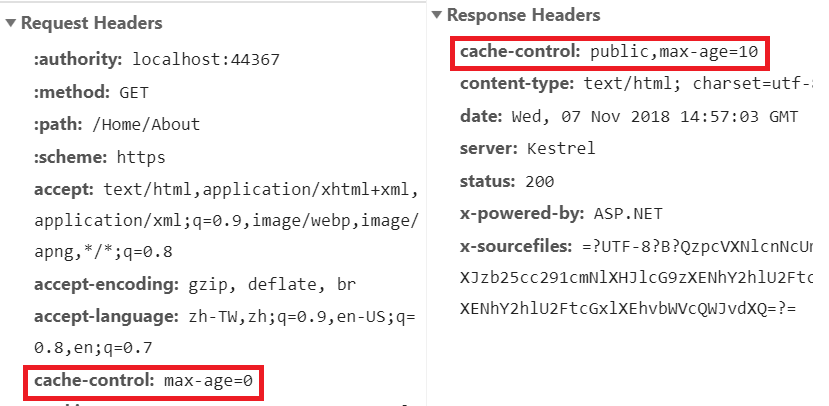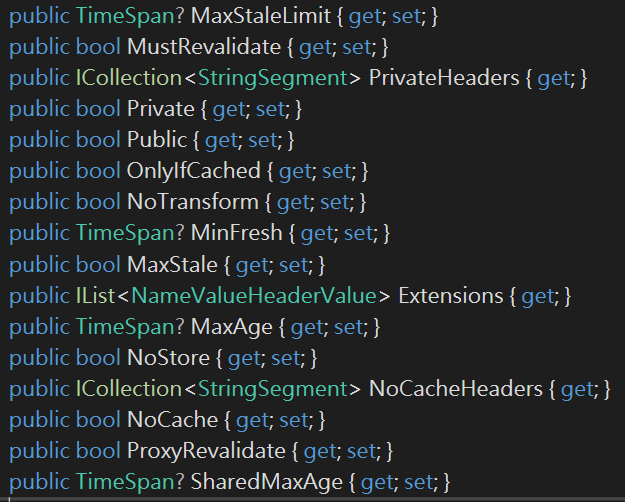本篇將延續上篇的Cache主題介紹Response Cache的使用方式。
Response Cache
接下來介紹經濟又實惠的Response Cache,
使用方式可分為以下兩種:
- ResponseCacheFilterAttribute
- Response Middleware
使用前記得在Startup中的ConfigureServices中加入服務。
public void ConfigureServices(IServiceCollection services)
{
services.AddResponseCaching();
services.AddMvc().SetCompatibilityVersion(CompatibilityVersion.Version_2_1);
}
我們使用Home/About來測試ResponseCacheFilterAttribute。
Duration可設定Cache的維持時間秒數(倒數計時方式),
我們將時間設為10秒。
[ResponseCache(Duration = 10)]
public IActionResult About(int? id)
{
ViewData["lastTime"] = DateTime.Now;
return View();
}
About.cshtml
@{
ViewData["Title"] = "About";
}
<div class="alert alert-success">
@ViewData["lastTime"]
</div>
好了之後來進行測試。

接著點選上方About的連結,
因為有設定ResponseCache,
所以會顯示一樣的時間,
但超過10秒時間就會更新。
一樣的行為我們使用F5來進行測試,
會發現得到的時間會一直更新,
這段也是讓我疑惑了一下,
感謝StackOverFlow的文章幫忙解惑,
摘述如下,如果有講錯請幫忙補充:
F5因為本身意圖就是要「重新整理」,所以預設並不會使用Response-Cache中的Content,
按下F5後比較Request跟Response Headers的差異,
可以看到Response雖然max-age=10,
但Request中直接設定max-age=0。

ResponseCache Middleware
Middleware是ASP.Net Core中另一種ReponseCache的使用方式,
我們可以在Startup的Configure中設定。
使用形式如下:
public void Configure(IApplicationBuilder app, IHostingEnvironment env)
{
app.Use(async (context, next) =>
{
context.Response.GetTypedHeaders().CacheControl =
new Microsoft.Net.Http.Headers.CacheControlHeaderValue()
{
Public = true,
MaxAge = TimeSpan.FromSeconds(10),
};
context.Response.Headers[Microsoft.Net.Http.Headers.HeaderNames.Vary] =
new string[] { "Accept-Encoding" };
await next();
});
app.UseMvc(routes =>
{
routes.MapRoute(
name: "default",
template: "{controller=Home}/{action=Index}/{id?}");
});
}
Microsoft.Net.Http.Headers.CacheControlHeaderValue中,
提供了許多ResponseCache中會設定到的參數(如下圖),

如果有需要細部客製調整的部份,
建議使用自訂的ResponseCacheMiddleware搭配ExtensionMethod使用。
另外官方也有介紹ResponseCacheMiddleware時常用的Header,
有興趣的讀者可以參考[此連結](https://docs.microsoft.com/zh-tw/aspnet/core/performance/caching/middleware?view=aspnetcore-2.1#http-headers-used-by-response-caching-middleware)。
Response Cache Condition
Response Cache使用上其實有很多條件限制,
不注意的話很可能在裡面繞了一大圈找不到方向,
以下限制條件摘錄自MSDN:
- Response回應的HttpStatusCode必須200。
- 請求方法必須符合Get或Head(Head=沒有Body的Get)。
- Header中不能含有Authorization、Set-Cookie。
- Header中Vary不能設定為*。
- Header中Cache-Control只能是public。
- 回傳結果在進入此層之前不能被修改(意思是Middleware順序比ResponseCache Middleware前面的不能修改Response的回傳結果)
- 回傳的Content大小不能超過MaximumBodySize
- Response Cache的總大小不能超過SizeLimit
- 不能設定成no-store或no-cache
- 不能使用IHttpSendFileFeature(非同步檔案傳輸跟Response Cache的使用情境衝突)
Reponse Cache的部分就簡介到這邊,
如有錯誤資訊再麻煩指正。
參考
https://docs.microsoft.com/zh-tw/aspnet/core/performance/caching/response?view=aspnetcore-2.1
http://www.talkingdotnet.com/response-caching-in-asp-net-core-1-1/
